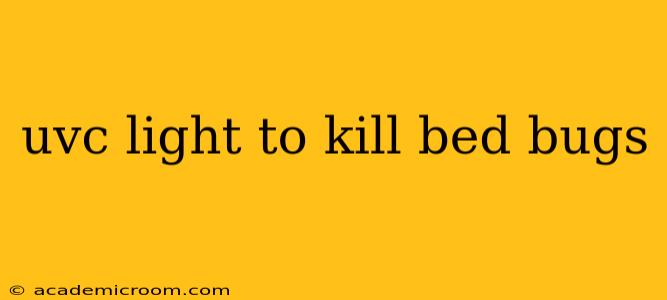Bed bugs are tiny, nocturnal insects that feed on human blood, causing itchy welts and sleepless nights. While various methods exist to combat these pests, the use of UVC light is gaining traction. This guide delves into the effectiveness, safety precautions, and limitations of using UVC light to eliminate bed bugs.
Does UVC Light Kill Bed Bugs?
Yes, UVC light can kill bed bugs, but it's crucial to understand that it's not a standalone solution and requires careful application. UVC light, a short-wavelength ultraviolet light, damages the DNA of microorganisms and insects, including bed bugs, preventing them from reproducing and ultimately leading to their death. However, direct, prolonged exposure is necessary for effective eradication. Simply shining a UVC lamp around the room won't suffice. Direct contact is key.
How Effective is UVC Light Against Bed Bugs?
The effectiveness of UVC light against bed bugs depends on several factors:
- Intensity of the UVC light: Higher intensity lamps are more effective at killing bed bugs.
- Exposure time: Bed bugs need sufficient exposure to UVC light to be killed. Shorter exposure times may only stun or partially affect them.
- Distance from the light source: The closer the bed bugs are to the UVC light source, the more effective the treatment will be.
- Surface area covered: UVC light only kills bed bugs it directly contacts. Thorough and repeated treatments are essential to reach all infested areas.
It's important to note that while UVC light can be a valuable tool in bed bug control, it's rarely a complete solution on its own. A comprehensive approach usually includes other methods such as steam cleaning, vacuuming, and professional pest control services for best results.
What are the Safety Precautions When Using UVC Light?
UVC light is harmful to human skin and eyes. Direct exposure can cause sunburn and eye damage. Therefore, stringent safety precautions are crucial:
- Never look directly at the UVC lamp.
- Wear protective eyewear: Use specialized UVC-blocking goggles or glasses.
- Wear protective clothing: Cover exposed skin with long sleeves and pants.
- Leave the room while the UVC lamp is operating: Ensure the area is completely unoccupied.
- Ventilate the room after treatment: Open windows and doors to dissipate any remaining ozone produced by the lamp. Ozone is a byproduct of UVC light and can be harmful to respiratory health.
Can UVC Light Kill Bed Bug Eggs?
UVC light is more effective at killing adult bed bugs and nymphs than eggs. Bed bug eggs are more resistant due to their protective shell. While UVC light can kill some eggs, it's less reliable than for adult bed bugs. Therefore, a multi-pronged approach targeting both adults and eggs is always recommended.
Is UVC Light a Permanent Solution for Bed Bugs?
UVC light is not a permanent solution for bed bugs. It's a tool to be used as part of a broader integrated pest management strategy. A single treatment is unlikely to eliminate a whole infestation. Repeated treatments may be necessary, alongside other methods such as thorough cleaning, steam cleaning, and insecticide application (if deemed necessary and by a professional).
What are the Alternatives to UVC Light for Bed Bug Control?
Several effective alternatives exist to UVC light for bed bug control, including:
- Professional pest control: Professionals have access to effective insecticides and treatments not available to the general public.
- Steam cleaning: High-temperature steam effectively kills bed bugs and their eggs.
- Vacuuming: Regular vacuuming can help remove bed bugs and their eggs, especially in crevices and cracks.
- Encasements: Mattress and box spring encasements prevent bed bugs from accessing these areas.
By combining UVC light with these other methods, you significantly improve your chances of effectively eliminating a bed bug infestation. Always remember to consult with a pest control professional for a comprehensive and safe solution.
